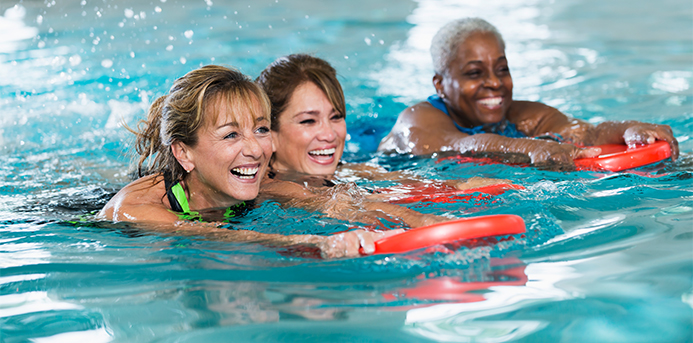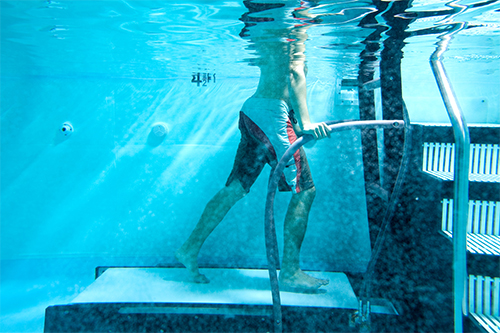Aqua therapy is an increasingly popular form of treatment and rehabilitation for patients with a broad range of illnesses and injuries. Here are some of the many benefits to hitting the pool for treatment, recovery or just a great aquatic workout.
We already know that water is an important part of maintaining good health, but the power of water can also be an important part of rehabilitation. Aqua therapy, also known as hydrotherapy and water therapy, can be a powerful and effective tool in the treatment of and rehabilitation from illness and injury. It can also be used to help people prevent further injury and to promote health and wellness.
Water therapy can work in a variety of ways and has myriad benefits. “Water therapy can be a wonderful environment to allow patients to gain strength and power and to enjoy freedom they may not have on land,” explains Amy Kennedy, doctor of physical therapy at the Illinois Bone and Joint Institute.
How Aqua Therapy Works
One of the reasons that water therapy works so well is because the water provides a great deal of buoyancy. Kennedy explains that once a patient is standing in water up to their belly button, the individual is supporting only half their weight thanks to the buoyancy of the water. The water supports up to three quarters of the body weight when the individual is in water up to their arm pits.
“You have buoyancy but you also have drag force, so you can get resistance. Resistance exercise while being supported can aid with bone density and allows your muscles to work easier or harder, whichever is needed,” says Kennedy.
“Buoyancy, viscosity and hydrostatic pressure help patients improve muscle tone and range of motion,” explains Jennifer Leipzig, licensed physical therapist assistant at Athletico Physical Therapy, who specializes in aquatic therapy services. She says that she can manipulate the viscosity of the water with given resistance tools to achieve optimal rehab potential.
Water therapy also alleviates stress on joints. Maggie Morrissy, exercise physiologist at the Shirley Ryan AbilityLab (formerly Rehabilitation Institute of Chicago), explains that the pool provides people with pain or arthritis a safe opportunity to engage in activity. That activity has benefits outside the pool. “As the client progresses with their water classes, they see a noticeable improvement in their day-today lives,” she says.
Another way that the water helps people heal and/or improve is through temperature. The Aquatic Exercise Association recommends that the water temperature for therapy and rehabilitation be between 90 and 95 degrees Fahrenheit. “Our pool is 93 degrees,” says Leipzig. “The water temperature prompts muscle relaxation, facilitates stretching and generally reduces the sensation of pain while increasing blood flow to injured areas.” In addition, the warm water can promote relaxation.
Another way that water therapy promotes relaxation is that patients have less fear than they often do with land-based rehabilitation, assuming they don’t have a fear of water or drowning. Often, they feel safer in the water. “There is no fear of falling. If they do fall, it’s a matter of getting their hair wet versus falling on their face, and that takes away a lot of anxiety,” says Kennedy.
In addition to improving muscle tone and range of motion, water therapy helps improve body awareness, proprioception (one’s sense of body and limb position) and core stability.
Hard Work Can Be Fun In The Water
Aqua therapy can also be more fun than land-based rehabilitation. “You can be as creative as you want in the pool,” says Kennedy. “The sky’s the limit.”
Morrissy agrees. “Of all the opportunities provided to our clients, I observe their universal enjoyment and pleasure from being in the pool,” she says. “Those with aches and pains ‘on land’ are able to move more freely in the pool and truly enjoy the activity.”
Patients may find therapy in the water both freeing and fun, but that doesn’t mean it’s not hard work. The professionals stress that there is much more to aqua therapy than the stereotypical water aerobics image many people have.
“There are common misconceptions that aqua therapy is only for older adults and that it is easy, both of which are false,” says Morrissy. “Whether you are a young athlete recovering from an acute injury or an older adult with a chronic condition, everyone has a spot in the pool and can benefit from training in water.”
Leipzig concurs. “Nearly every patient says the workout that they completed [in the water] was more challenging than they expected,” she says.
Considerations Before Beginning Aqua Therapy
“While there is considerable research effectively documenting the value of water therapy in various setting and for multiple diagnoses, it comes down to both the therapist’s skills and the patient’s diagnosis as to the exact benefit of this intervention for a specific patient,” according to the American Physical Therapy Association.
Water therapy may not be right for everyone. Kennedy cautions that people who are cardiac compromised need to be cleared by their doctor.
Also, there are safety considerations that must be taken into account when someone has been cleared for water therapy. People often feel great in the water and want to keep going, but Kennedy cautions that it is important to not overdo it. Also, people need to be very cautious when exiting the pool, as slipping on the wet floor is always a danger.
Patients Who Benefit Most From Aqua Therapy
“Lumbar fusions are the number one diagnosis I treat,” says Leipzig. “Aquatic therapy is also effective in treating chronic pain, gait and balance disorders, deconditioning and postoperation recovery and injuries with weight bearing limitations,” she adds.
Kennedy says that rheumatological patients often do very well with water therapy as do children, particularly those with spasticity and cerebral palsy. “If they are wheelchair bound, they have freedom in the water that they don’t have on land,” she says.
While water therapy can be a beneficial and important element of physical therapy, it shouldn’t be the only tool used. “We are not mermaids or fish, so we have to transition to land, too,” explains Kennedy.
Even if you aren’t recovering from anything specific and do not require aqua therapy with a physical therapist or physical therapist assistant, water-based exercise can still be beneficial. Morrissy says aqua classes are appropriate for many populations, and suggests speaking with your physician about your exercise program and whether pool exercise is an appropriate option. The Centers for Disease Control and Prevention agrees, calling water-based exercise a “good choice” and noting, “Exercising in water offers many physical and mental health benefits and is a good choice for people who want to be more active.”


